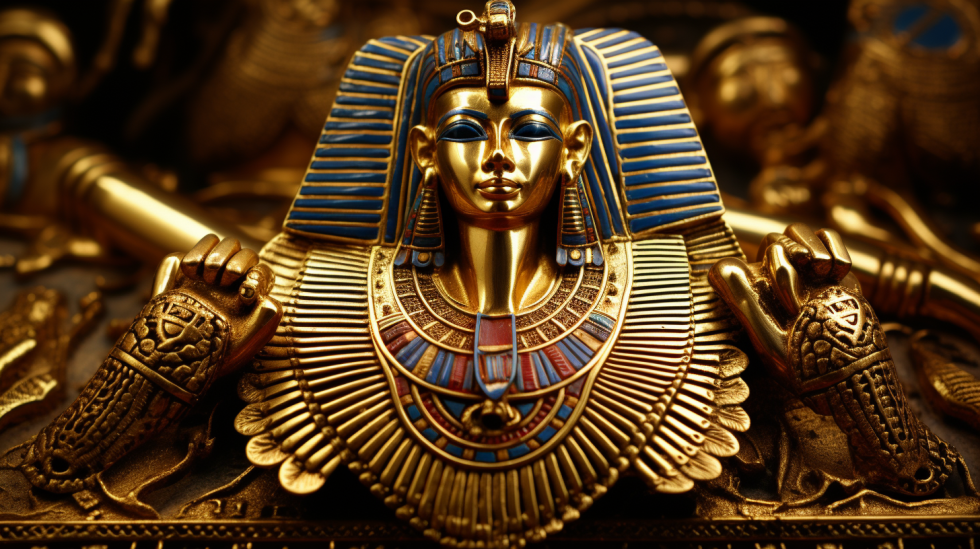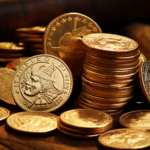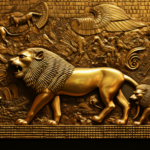Ancient Egypt, with its grand pyramids, enigmatic sphinxes, and magnificent temples, is a civilization that has left an indelible mark on history. At the heart of Egypt’s splendor lay a precious metal that symbolized divine power, eternal life, and unmatched wealth—gold. In this exploration of “Gold in Ancient Egypt,” we will uncover the profound significance of gold in this ancient civilization, its various uses, and its role in shaping the culture and legacy of the pharaohs.

The Sacred Metal: Gold’s Divine Connection
Gold held a revered and sacred status in the ancient Egyptian civilization. It was believed to possess divine qualities and was closely associated with the gods and the pharaohs. Here are some key aspects of gold’s divine connection:
1. The Sun God Ra
In ancient Egyptian mythology, the sun god Ra was often depicted as a golden disk or a man with the head of a falcon crowned with a solar disk. Gold, being radiant and unchanging, symbolized the sun’s eternal and life-giving power, making it an apt representation of Ra.
2. The Afterlife and Immortality
Gold was considered a symbol of immortality and resurrection in ancient Egypt. It was believed that the flesh of the gods was made of gold, and the deceased pharaohs were thought to become gods in the afterlife. As such, gold was used extensively in funerary rituals and tombs.
3. The Divine Pharaoh
The pharaoh, the ruler of Egypt, was considered a living god. Gold was used to adorn the pharaoh’s regalia, including the crowns, jewelry, and ceremonial artifacts, signifying their divine status and their role as intermediaries between the mortal world and the gods.
Gold’s Many Roles in Ancient Egypt
Gold played a multifaceted role in the daily life, culture, and economy of ancient Egypt. Its applications were as diverse as the civilization itself. Here are some of the key roles gold played:
1. Funerary Rituals and Tombs
Gold was an integral part of Egyptian burial practices. It adorned the coffins, sarcophagi, and burial masks of pharaohs and nobles, symbolizing their journey to the afterlife. The famous burial mask of Tutankhamun, crafted from solid gold, is an iconic example of this tradition.
2. Jewelry and Adornments
Gold jewelry was highly prized and worn by both the elite and the common people. Egyptians crafted exquisite necklaces, bracelets, rings, and earrings from gold, often featuring intricate designs and inlays of colorful gemstones.
3. Temples and Religious Artifacts
Gold was used in the construction and decoration of temples and religious artifacts. Gilded statues, golden altars, and gold leaf adorned sacred spaces, further emphasizing the divine connection between gold and the gods.
4. Currency and Trade
Gold was one of the earliest forms of currency in ancient Egypt. It facilitated trade and economic transactions, and its value was universally recognized. Gold rings and bars were used for trade, with each piece stamped to indicate its purity.
5. Embalming and Preservation
In the process of mummification, gold was used to encase specific organs, such as the heart and lungs, in protective amulets. This was believed to ensure the deceased’s organs were preserved for the afterlife.
6. Royal Regalia
Pharaohs and queens adorned themselves with gold crowns, headdresses, and other regalia. The crowns, often combined with lapis lazuli and other precious stones, symbolized the rulers’ authority and divine mandate.
7. Alchemical and Medicinal Uses
Gold was associated with health and vitality. Some ancient Egyptians believed in the medicinal properties of gold, and it was used in various elixirs and remedies. Additionally, gold was used in early alchemical practices.
8. Monumental Structures
Gold was used in the construction of monumental structures, including the covering of obelisks and the gilding of temple walls. The use of gold leaf in architectural elements enhanced their grandeur.
Mining and Sources of Gold
The ancient Egyptians sourced their gold from various locations, both within Egypt and from neighboring regions. Some of the primary sources of gold included:
1. Nubia (Kush)
Nubia, located to the south of Egypt, was a rich source of gold. The Egyptians established trade routes and conducted expeditions to Nubia to extract gold from its mines. The land of Punt, possibly located in modern-day Eritrea or Somalia, was another important source of gold.
2. The Eastern Desert
Egypt’s Eastern Desert contained numerous gold mines, some of which dated back to the Early Dynastic Period (c. 3100-2686 BCE). The Wadi Hammamat region, in particular, was known for its gold deposits.
3. Riverbeds and Alluvial Deposits
Gold was also found in riverbeds and alluvial deposits, especially along the Nile River. This type of gold was often extracted through panning and simple mining techniques.
4. Tribute and Trade
Egypt received gold as tribute from vassal states and through trade with neighboring civilizations, such as the Hittites and the Mesopotamians.
The Craftsmanship of Egyptian Goldsmiths
Egyptian goldsmiths were revered for their exceptional craftsmanship and skill in working with gold. They employed various techniques to create intricate and beautiful jewelry and artifacts. Some of their methods included:
1. Filigree
Filigree involves the intricate twisting and soldering of fine gold wires to create delicate patterns and designs. It was commonly used in jewelry making.
2. Granulation
Granulation is the process of fusing tiny gold granules onto a gold surface to create a textured appearance. This technique added depth and detail to jewelry.
3. Repoussé and Chasing
Repoussé involves hammering the reverse side of a gold sheet to create a raised design on the front, while chasing is the opposite process, where designs are engraved or hammered from the front to add detail.
4. Inlay and Enamel
Gold jewelry often featured inlays of colorful gemstones, such as turquoise and lapis lazuli, or enamel work to enhance its beauty.
Gold in Ancient Egyptian Burial Practices
The use of gold in ancient Egyptian burial practices was extensive and profound, reflecting their beliefs about the afterlife and the importance of preserving the deceased pharaohs and nobles. Here are some key aspects of gold’s role in Egyptian funerary traditions:
1. Mummification and Gilding: Gold was used in the mummification process. The most famous example is the gold mask that covered the face of Tutankhamun’s mummy. Gold was also used to gild the sarcophagi and coffins of the deceased, creating a splendid and regal appearance.
2. Amulets and Funerary Jewelry: Gold amulets and jewelry were placed on the bodies of the deceased to provide protection and aid in their journey to the afterlife. These items often featured symbolic motifs and inscriptions.
3. The Opening of the Mouth Ritual: This important ceremony was performed during the burial process. A priest would use a special implement made of gold, called the “adze of gold,” to symbolically open the mouth of the deceased, enabling them to speak and partake in the afterlife.
4. Canopic Jars: Gold was used to create canopic jars that held the preserved internal organs of the deceased. Each jar was associated with a specific organ and a protective deity.
5. Funerary Texts: Some funerary texts, such as the Pyramid Texts and the Book of the Dead, were written or inscribed on gold sheets and placed in the tombs to guide and protect the deceased in the afterlife.
6. Treasures for Eternity: The tombs of pharaohs and high-ranking officials were filled with vast treasures, including gold, to ensure their comfort and prosperity in the afterlife. These treasures were guarded by intricate traps and mechanisms to deter tomb robbers.
7. The Golden Death Mask: The death mask of a pharaoh was one of the most iconic uses of gold in ancient Egyptian burial practices. The mask of Tutankhamun, crafted from solid gold and inlaid with precious stones, is perhaps the most famous example. These masks not only adorned the mummies but also served as protective amulets.
The Legacy of Egyptian Gold
The legacy of gold in ancient Egypt extends far beyond the sands of time. It continues to influence our understanding of history, art, and the enduring allure of this precious metal. Here are some ways in which the legacy of Egyptian gold endures:
1. Archaeological Discoveries: Ongoing archaeological discoveries in Egypt reveal new insights into the use of gold in ancient times. These discoveries contribute to our understanding of Egyptian civilization and its cultural and religious practices.
2. Artistic Inspiration: The exquisite gold jewelry and artifacts created by ancient Egyptian goldsmiths continue to inspire contemporary jewelry designers and artisans worldwide. Elements of Egyptian motifs and techniques are often incorporated into modern jewelry.
3. Museum Collections: Museums around the world house extensive collections of Egyptian gold artifacts and jewelry. These exhibitions allow people to appreciate the artistry and craftsmanship of the ancient Egyptians.
4. Symbolism and Iconography: Symbols and motifs associated with Egyptian gold, such as the ankh (symbolizing life), the scarab beetle (symbolizing rebirth), and the Eye of Horus (a protective symbol), continue to be used in art, jewelry, and design.
5. Cultural Impact: The allure of Egyptian gold has left a lasting impact on popular culture, with countless books, films, and art pieces drawing inspiration from the mystique of ancient Egypt.
Conclusion: A Gilded Legacy
Gold in ancient Egypt was more than just a precious metal; it was a symbol of divinity, wealth, and eternal life. Its significance permeated every aspect of Egyptian society, from religious ceremonies to royal regalia, and from funerary rituals to everyday adornments.
The gilded legacy of Egyptian gold endures as a testament to the remarkable achievements of this ancient civilization. It serves as a reminder of humanity’s enduring fascination with the radiant metal, its artistic and cultural impact, and the profound beliefs and practices that made gold an integral part of Egypt’s rich history.
As we gaze upon the treasures of the pharaohs and the dazzling craftsmanship of their goldsmiths, we glimpse a civilization that valued not only the material wealth of gold but also the spiritual and cultural riches it represented. The legacy of Egyptian gold is a gilded tapestry woven with threads of history, artistry, and the timeless pursuit of transcendence.



